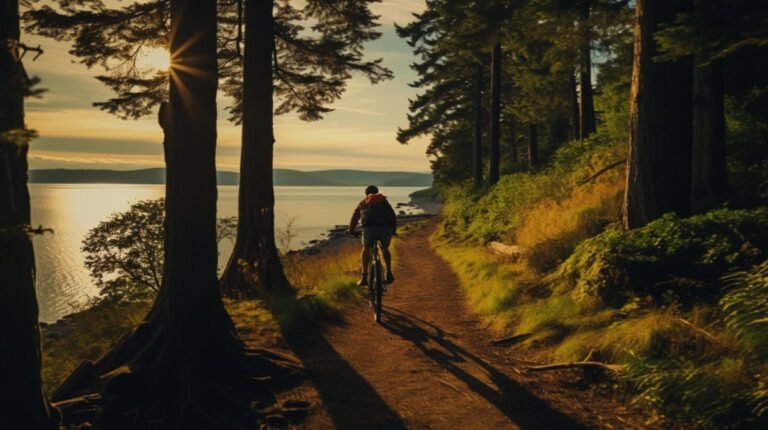Biking in Winter
Don’t let winter stop your biking adventures! Explore the joys and challenges of biking in winter with our tips and gear suggestions. Embrace the cold and stay active on two wheels.
Biking in winter may seem like a daunting challenge, but it’s a fantastic way to stay active and maintain your cycling passion all year round. While the chilly weather might discourage some, there are compelling reasons to hop on your bike even when the snow falls.
Winter biking allows you to embrace the great outdoors during a season when many people choose to hibernate indoors. It’s an opportunity to experience the serene beauty of snow-covered landscapes and enjoy the crisp, invigorating air.
By pedaling through winter, you can maintain your fitness, reduce stress, and boost your mood.
Benefits of Winter Biking
Winter biking isn’t just about overcoming challenges; it offers a range of benefits too.
Essential Biking Gear for Rainy Days
Stay Fit and Active
Firstly, it’s an excellent way to stay fit and active during the winter months. Unlike many other activities, biking engages multiple muscle groups and provides an efficient cardiovascular workout.
Save Money
Secondly, winter biking can save you money. When you choose your bike over a car or public transportation, you reduce fuel and transportation costs.
Plus, you’ll likely spend less on gym memberships and fitness classes since you’ll be staying active outdoors.
Environmental Advantages
Thirdly, there are environmental advantages to winter biking. By choosing a bike over a car, you reduce your carbon footprint and contribute to a cleaner environment.
In this comprehensive guide, we will walk you through everything you need to know about biking in winter. From selecting the right equipment to staying safe on icy roads, we’ve got you covered.
Biking Tours for Nature Enthusiasts
We’ll also explore the benefits of winter biking and provide encouragement for you to give it a try.
So, let’s dive into the world of winter cycling!
Preparation for Winter Biking
Choosing the Right Bike
Types of Bikes Suitable for Winter
When it comes to winter biking, the type of bike you choose plays a crucial role. Fat bikes, mountain bikes, and hybrid bikes are excellent choices.
Fat bikes, with their oversized tires, offer superior traction on snow and ice. Mountain bikes provide stability and durability, while hybrids offer versatility for various winter conditions.
Necessary Modifications and Accessories
To make your bike winter-ready, consider adding studded tires for extra grip on icy surfaces. Fenders will help keep slush and snow off you and your bike, while wider handlebars provide better control. Additionally, invest in quality brakes suitable for wet and icy conditions.
Clothing and Gear
Layering for Warmth
Layering is key to staying warm during winter rides. Start with a moisture-wicking base layer to keep sweat away from your skin.
Add insulating layers for warmth and finish with a windproof and waterproof outer shell to protect against the cold and precipitation.
Winter-Specific Biking Apparel
Invest in winter-specific biking gear such as thermal jerseys, tights, and shoe covers. These items are designed to provide warmth and comfort while allowing for ease of movement and breathability.
Essential Safety Gear
Never compromise on safety. Wear a well-fitted helmet at all times. Equip your bike with bright front and rear lights, and add reflective materials to your clothing and bike to enhance visibility, especially during low-light conditions.
Bike Maintenance
Winterizing Your Bike
Prepare your bike for winter by ensuring your tires are properly inflated, and brakes and chain are in good condition. Lubricate moving parts with a winter-specific lubricant that won’t freeze in cold temperatures.
Cleaning and Lubricating Components
After each winter ride, clean your bike thoroughly to remove salt and grime. Lubricate the chain and other moving parts to prevent corrosion.
Route Planning
Identifying Safe and Well-Maintained Routes
Plan your routes carefully, choosing well-maintained roads and trails. Check local bike maps and online resources for winter-friendly routes.
Alternative Routes for Inclement Weather
Be prepared for changing weather conditions. Have alternate routes in mind for days when the roads become impassable due to heavy snow or ice.
How Dangerous is Mountain Biking
In conclusion, winter biking offers a unique opportunity to stay active and connected with nature during the colder months. It promotes fitness, saves money, and benefits the environment.
The preparations will help you start your winter biking adventure on the right foot, ensuring you’re comfortable, safe, and ready to tackle the cold.
Embrace the snowy landscapes and enjoy the ride!







